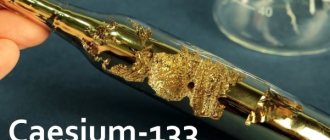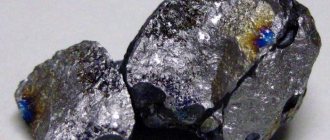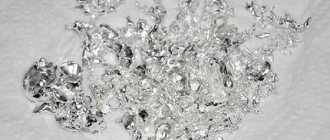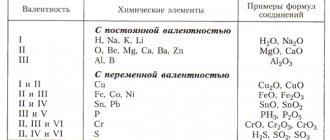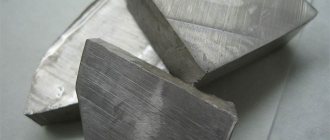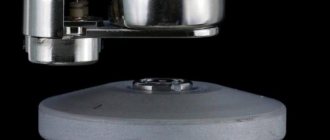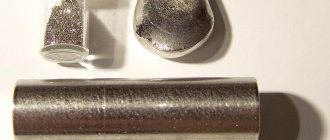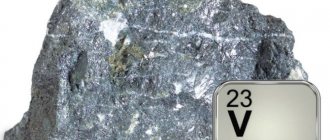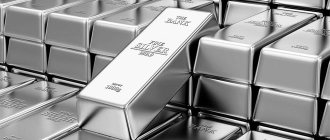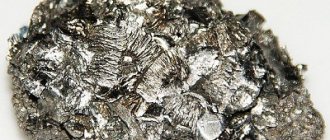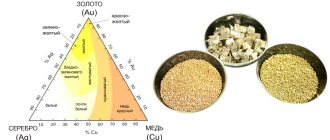How it was opened
The history of metal begins with the Middle Ages:
- He is mentioned by the healers and alchemists Paracelsus, Vasily Valentin, Gregory Agricola.
- Used by Johannes Gutenberg when casting fonts for printing the first European books.
Bismuth was known as a metal before, but was mistaken for tin, lead or antimony. It is not for nothing that the name is associated with the Arabic “like antimony” and the German “white mass” (as local miners dubbed it).
It was not until the 18th century that chemists classified bismuth as an independent element.
In Russia, the history of the discovery is associated with the name of Mikhail Lomonosov. The scientist made the first descriptions of the metal.
Story
The history of the discovery of metal stretched over centuries. For a long time it was confused with tin, lead, and antimony.
For the first time, Agricola, the “father of mineralogy,” spoke about bismuth as a separate element. Almost three centuries later, the chemist Pott proved this, and Berzelius assigned the metal its own symbol (Bi) and gave it a place in the chemical nomenclature of the elements.
DI. Mendeleev wrote:
“The heaviest analogue of nitrogen and phosphorus is bismuth... In many properties it resembles antimony and lead.”
Physico-chemical characteristics
For a chemist, bismuth is a simple substance. In microclimates with normal indicators, it is chemically inert. The interaction begins at +990°C.
The metal is low-melting, and at +150°C it becomes plastic. However, it is fragile, lacks ductility, malleability, and is easily crushed to powder.
| Properties of the atom | |
| Name, symbol, number | Bismuth (obsolete Bismuth) / Bismuthum (Bi), 83 |
| Atomic mass (molar mass) | 208.98040(1) a. e.m. (g/mol) |
| Electronic configuration | [Xe] 4f14 5d10 6s2 6p3 |
| Electrons by shell | 2, 8, 18, 32, 18, 5 |
| Atomic radius | 170 pm |
| Chemical properties | |
| Covalent radius | 146 pm |
| Ion radius | (+5e) 74 (+3e) 96 pm |
| Electronegativity | 2.02 (Pauling scale) |
| Electrode potential | Bi←Bi3+ 0.23 V |
| Oxidation states | 5, 3 |
| Ionization energy (first electron) | 702.9 (7.29) kJ/mol (eV) |
| Thermodynamic properties of a simple substance | |
| Density (at normal conditions) | 9.79 g/cm³ |
| Melting temperature | 271.44 °C, 544.5 K |
| Boiling temperature | 1837K |
| Ud. heat of fusion | 11.30 kJ/mol |
| Ud. heat of vaporization | 172.0 kJ/mol |
| Molar heat capacity | 26.0 J/(K mol) |
| Molar volume | 21.3 cm³/mol |
| Crystal lattice of a simple substance | |
| Lattice structure | rhombohedral |
| Lattice parameters | α=57.23°, a=4.746 Å |
| c/a ratio | – |
| Debye temperature | 120.00 K |
| Other characteristics | |
| Thermal conductivity | (300 K) 7.9 W/(m K) |
| CAS number | 7440-69-9 |
A number of characteristics of the metal distinguish it from others:
- In the cold, like water, it increases in volume.
- Has low thermal conductivity.
- The strongest diamagnetic among metals.
Does not interact with silicon, nitrogen, carbon, dilute sulfuric, concentrated hydrochloric acids, alkalis.
Toxicity
Bismuth salicylate and bismuth thioglycolate, used to combat syphilis and other infectious or parasitic diseases, when administered parenterally can cause a picture of bismuth poisoning. When administered orally, bismuth nitrate can be metabolized to nitrites, which are absorbed from the intestine and methemoglobinized. [18] Acute poisonings cause headaches, gastroenteritis, liver disease, anuria and shock.
. In case of chronic poisoning, stomatitis, cyanosis of the gingival border, enteritis, jaundice, nephropathy, rash or exfoliative dermatitis are observed. [ 18 ]
Treatment of acute poisoning consists of administering dimercaprol and drinking plenty of fluids, unless there is kidney damage, in which case it should be treated in the same way as endemic regional chronic hydroarsenism. [ 18 ]
Metal in nature
The element belongs to the rare earth metals.
A ton of the earth's crust contains 2 g of bismuth.
In nature, nuggets are very rare; other types are more often represented:
- As an impurity in ores - lead, tungsten, copper, zinc, tin.
- As a component of minerals - bismuthin, cosalite, bismuthin, bismith, and others.
The focus was on the metal isotope. Until the beginning of the 21st century, it was considered stable, but later it was discovered that bismuth is radioactive. This is not dangerous.
The half-life of bismuth is orders of magnitude greater than the age of the Universe (14.5 billion years).
Bismuth price
for bismuth rarely drops below 2,000 rubles per kilogram. This cost is indicated for purchases with minimum volumes. That is, you can save only when ordering from 5, 10, 16 kilograms. If you take only 1,000 grams, you will have to pay at least 3,100 rubles. Standard price - from 4,000 to 6,000 rubles.
Sellers' requests depend on the purity of the metal. Its content in ingots can be, for example, 99%, or maybe 99, 99%. The name of the manufacturer, trader and the country from which the goods were delivered are also taken into account. For Russians, supplies from China are most profitable. If we talk about enterprises within the country, bismuth is sold, for example, by Elektrovek-Stal.
Plant managers set prices based on London Non-Ferrous Metals Exchange indices. As a rule, the cost of a kilogram of bismuth varies between 3,000 – 4,000 rubles. The enterprise's production volumes allow it to trade in centners, which significantly reduces costs for large purchases.
Receiving technology
Like other rare elements, the Bi content in rocks is calculated in fractions of a percent. Therefore, the first point of ore delivery is the processing plant. The methods of pyro- and hydrometallurgy are used here.
Synthetic bismuth crystal and 1 cm3 ingot
Pyrometallurgy
The enrichment procedure is multi-stage, determined by the origin of the raw material:
- Bismuth from compounds isolated during the processing of copper concentrates is precipitated by smelting with ferro scrap.
- The element is reduced from oxidized ores under the “cover” of a low-melting flux. The procedure requires carbon and 990°C.
The most common source for bismuth production is rough lead. Bismuth is isolated by exposure to magnesium or calcium. Then these elements are removed by flotation, purification, and electrolysis. Rough bismuth is obtained by melting the mass.
Hydrometallurgy
Hydrometallurgical method:
- Bismuth-containing raw materials are dissolved with acids.
- Solutions are leached electrochemically or with sulfuric acid.
- The element is extracted and purified by extraction.
- High-purity metal is obtained by refining, zone smelting, and distillation.
The method is found to be cost-effective: concentrates with a minimal amount of bismuth are suitable for extracting the product. The quality is impeccable.
Reserves and production
The usual origin of bismuth ores is hydrothermal, pegmatite, and contact-metasomatic.
Bismuthum's own minerals:
- bismuth luster;
- bismith;
- cosalite.
The metal is chemically inactive and therefore occurs in nature in its native form.
Interesting: the weight of some nuggets reaches 15 kg.
Extraction is carried out from bismuth ores (a small part of the extraction). The main volumes of Bi are extracted from non-ferrous and precious metal ores. These include:
- lead-zinc;
- tin:
- copper;
- tungsten;
- gold-bearing
Countries with bismuth ore deposits:
- China;
- Bolivia;
- Germany;
- Russia;
- Australia.
The metal ranks 71st in terms of reserves in the earth's crust among all elements.
Synthetic bismuth crystal and ingot with a volume of 1 cm3.
Where is metal used?
Microdoses of metal added to steel, cast iron, and aluminum facilitate machining. This property of bismuth was appreciated by metallurgy - the main consumer of the metal.
Industry
The industrial complex uses all forms of matter.
Metal
This is the liquid in thermometers, the material of models for molds in foundries.
Alloys
Alloys “bismuth + metals (cadmium, lead, tin)” are low-melting.
Their application is universal:
- circuit breakers;
- valves;
- valves;
- solders, lubricants;
- gaskets-seals for units operating in vacuum;
- bearing parts.
They are used to make caps for armor-piercing shells and reactor coolants at nuclear power plants.
Bismuth + manganese, chromium, indium or europium are valued by manufacturers of permanent magnets.
Bismuth telluride single crystal
Connections
Modifications of bismuth are the basis of special-purpose materials (superconductors, magneto-, thermoelectric):
- Material of electrochemical fuel units.
- Ion radiation detectors in devices for the needs of geology, computed tomography, nuclear physics.
- Catalysts in the production process of acrylic polymers.
They are used by oil refiners.
Defense complex
The advantages of the metal suited the military-industrial complex. Bismuth compounds are used in the production of batteries for the army and spacecraft.
Even the shavings do not go to waste - they are used as an accelerator for the manufacturing process of rocket fuel components.
Medicine
Compounds of the element are in demand in medicine as components of drugs:
- They treat the gastrointestinal tract, oncology, disinfect and heal wounds.
- Injected into a contrast agent for fluoroscopy.
Bismuth-containing medications kill bacteria that cause stomach ulcers.
Traumatologists use it as a material that fixes areas with fractures. Dentists use it for prosthetics.
Other areas
High purity material is intended for scientists:
- Instruments that measure the parameters of magnetic fields are made from it.
- This is the source for the synthesis of other elements.
It is added to make pigments, enamels for ceramics, glass, nail polish, fishing rod sinkers, and shot from hunting cartridges.
Avant-garde style jewelry is created from crystals.
You can grow crystals at home and admire their intricately chaotic structure.
Alloys
Bismuth alloys are widely used.
The most famous of them is Wood's alloy. The composition includes bismuth, lead, tin and cadmium. Used as low-melting solders (alloy melting point 68.5°C).
Interesting: one joker made teaspoons from Wood's alloy. It was impossible to distinguish them from ordinary ones. But in hot tea the spoon melted and dripped to the bottom of the cup.
| Alloy, grade | Amount of additives, microadditives of bismuth |
| LTs37Mts2S2K (cast brass) | Up to 0.01% |
| AMF (copper) | Up to 0.001% |
| MH95-5 (copper-nickel) | Up to 0.002% |
| MF9 (copper-phosphorus) | Up to 0.005% |
| НХМ9 (nickel) | Up to 0.002% |
| POS40 (tin-lead solder) | Up to 0.2% |
We recommend: MOLYBDENUM - a universal metal
Warning
The substance is environmentally safe for all living things.
However, it is a radioactive metal, so you need to be careful when taking pharmaceutical drugs with it:
- Some food products, interacting with medicine, provoke the formation of toxic compounds in the body.
- A long dosage cycle is contraindicated for people with kidney disease.
Overdose symptoms:
- Gastrointestinal upset (nausea, vomiting, diarrhea).
- Heart problems.
- Memory impairment.
- Loss of appetite.
- Insomnia.
- Inflammation of the gums.
- Dermatitis.
- Toxic hepatitis.
This can be avoided by strictly following the instructions included with the drug.
Application
Bismuthum is used in:
- metallurgy;
- precision engineering;
- cosmetic industry;
- pharmacy;
- crystal production.
By bombarding bismuth with neutrons, polonium-210 is obtained.
Bismuth telluride single crystal
Bi2Te3 is used in thermoelectric refrigerators.
Bismuth compounds are used in medicine:
- vikair;
- vikalin;
- subsalicylate;
- tartrate.
Synthesized bismuth crystal. The oxide film gives the rainbow color.
Medicines based on them have a mild laxative, antiseptic, and anti-inflammatory effect.
Informative: after the explosion of an oil platform in the Gulf of Mexico, birds were given bismuth salts to remove oil products from the body.
China is developing low-power lead-bismuth reactors.
References
- Agricola, Georgius (1955) [1546]. On the Nature
of Fossils New York: Mineralogical Society of America. item 178 - Nicholson, William (1819). "Bismuth". American edition of the Encyclopædia Britannica: Or, Dictionary of Arts and Sciences;
incorporating an accurate and popular representation of the present improved state of human knowledge . paragraph 181. - ↑ a b
Weeks, Mary Elvira (1932).
"Discovery of the Elements. II. Elements known to alchemists." Journal of Chemical Education 9
: 11. Bibcode: 1932JChEd…9…11W. DOI: 10.1021/ed009p11. - Giunta, Carmen J. Glossary of Archaic Chemical Terms, Le Moyne College. See also other terms for bismuth, including stannum glaciale
(ice tin or ice tin). - Pott, Johann Heinrich (1738). Bismuth _ Chemistry
_ Berolini: Apud John Andrea Rudiger. item 134 - Hammond, C. R. (2004). Elements in Handbook of Chemistry and Physics (81st edition). Boca Raton (Florida, USA): CRC Press. clause 4-1. ISBN 0-8493-0485-7.
- Geoffroy (1753). "About bismuth". History of the Royal Academy of Sciences ... with dissertations on mathematics and physics ... extract from the registers of this Academy
: 190. - Gordon, Robert B.; Rutledge, John W. (1984). "Bismuth bronze from Machu Picchu, Peru." Science 223
(4636):585-586. Bibcode: 1984Sci…223..585G. JSTOR 1692247. PMID 17749940. doi: 10.1126/science.223.4636.585. - Harper, Douglas. "bismuth" Online Dictionary of Etymology
. - Norman, Nicholas S. (1998). Chemistry of Arsenic, Antimony and Bismuth. paragraph 41. ISBN 978-0-7514-0389-3.
- "The Secrets of Bismuth: It Will Be the Last Element in the Universe to Go Extinct" at xatakaciencia.com.
- Hopper KD, King SH, Lobell ME, TenHave TR, Weaver DS. (1997). “Breast: planar X-ray protection during diagnostic CT of the chest - shielding with bismuth radioprotective clothing.” Radiology 205
(3):853-8. PMID 9393547. doi: 10.1148/radiology.205.3.9393547. - Carlin, James F., Jr.
USGS Minerals Yearbook 2010: Bismuth (PDF). US Geological Survey. Consultado el September 9, 2010. - Lohse, Joachim; Zangle, Stephanie; Gross, Rita; Gensch, Karl-Otto; Deubser, Otmar (September 2007). "Adaptation to scientific and technological progress of Annex II of Directive 2000/53/EC" (PDF). European Commission. Retrieved September 11, 2009
- Kruger, Joachim; Winkler, Peter; Lüderitz, Eberhard; Luke, Manfred; Wolf, Hans Ove (2003). "Bismuth, bismuth alloys and bismuth compounds". Ullman Encyclopedia of Industrial Chemistry. Wiley-VCH, Weinheim. pp. 171-189
- Mayle, Frank J.; Pfaff, Gerhard; Reynders, Peter (2005). "Performance pigments - past, present and future." Progress in Organic Coatings 54
(3): 150. doi: 10.1016/j.porgcoat.2005.07.003. - Pfaff, Gerhard (2008). Special Effects Pigments: Technical Basics and Applications. Vincent Network GmbH. paragraph 36. ISBN 978-3-86630-905-0.
- ^ A b c
Calabrese, Alberto I.;
Astolfi, Emilio A. (January 1969). Toxicology
. Buenos Aires, Argentina: Capelos. pp. 146-147. OCLC 14501248. - ^ A b c de e
F. Burriel Martí, F. Lucena Conde, S. Arribas Jimeno, J. Hernández Mendez (2006)
.
"Analytical chemistry of cations: bismuth".
Qualitative Analytical Chemistry
(18th Edition). Thomson. ISBN 84-9732-140-5.
Biological role
The effect of bismuth on human physiology has not been fully studied. It is known that it enters the body every day with water, food and air in an amount of 4-20 mcg. A regular dose of more than 1-1.5 g leads to poisoning of the body.
Bismuth is involved in protein synthesis at the cellular level and other biological processes. Its toxicity for a living organism approaches zero, so the chemical element in question does not pose a danger to humans if it is not abused.
Bi is mainly localized in the spleen, liver, kidneys (0.4 μg), bones (up to 0.2 μg), and to a lesser extent in the brain. Its presence was noted in the blood (<3 μg/l). Excreted in feces and urine. Passing through the gastrointestinal tract, Bi is converted into bismuth sulfide, which turns stool dark.
Oxidation states
Bismuth(III)
Bi
cation due
to its moderately high acidity, is only in strongly acidic solutions in a state of equilibrium with its oxides. The Bi 3+ cation is colorless due to the stability of its electronic configuration ([ ] 6s 2 ), which prevents electronic transitions at wavelengths in the visible spectrum. [ ]
Acid-base behavior
As the alkalinity of the medium increases, the Nos Bi 3+ cation mainly forms monohydroxobismuth (III) forms BiOH 2+ and bismuthyl cation BiO + . [ 19 ]
Bi 3+ + OH - Bi(OH) 2+ Bi 3+ + 2OH - BiO + + H 2 O
At a highly alkaline pH, bismuth(III) hydroxide, Bi(OH)3, is formed, which upon dehydration forms dibismuth trioxide, Bi2O3, a yellow solid. [ 19 ]
BiO + + 4OH - Bi(OH) 3 ↓ + H 2 O 2Bi(OH) 3
(t)
→ Bi 2 O 3
(t)
+ 3H 2 O
In extremely alkaline environments, the bismuth anion BiO 2 - is formed. [ 19 ]
Bi 2 O 3
(t)
+ 2OH - 2BiO 2 - + H 2 O
Presence in organic compounds
It can be found forming covalent bonds in some organic compounds.
- Trimethylbismuthano
- Bismuth oxysalicylate
- Bismuth thioglycolate
Bismuto (V)
Unlike bismuth(III), it is not free as a cation or in strongly acidic environments due to its high instability due to the high value of its charge/mass ratio. [ 19 ]
Some of the compounds in which it is found are:
- Bi 2 O 5, dibismuth pentoxide
- BiF5, bismuth(V) fluoride
- NaBiO 3, sodium metabismuthate
Problem with a new temperature scale
In a physics course, you can come across a problem to determine the melting point of bismuth on the Genius scale. Let's say right away that this is just a task, and there is no Genius scale. In physics, only three temperature scales are currently accepted: Celsius, Fahrenheit and Kelvin (in the SI system).
So, the conditions of the problem are as follows: “The new temperature scale, which is expressed in degrees Genius (°G), is related to the Celsius scale as follows: 0 °G = 127 °C and 80 °G = 255 °C, you need to determine the melting point of bismuth in degrees new scale."
The difficulty of the problem is that the interval of 1 °G does not correspond to the interval of 1 °C. What value does it correspond to in Celsius? Using the problem condition, we obtain: (255-127)/80 = 1.6 °C. This means that a 1°G increase in temperature is equivalent to a 1.6°C increase. To solve the problem, remember that bismuth melts at a temperature of 271.4 °C, which is 16.4 °C or 10.25 °G (16.4/1.6) higher than the temperature of 255 °C. Since a temperature of 255 °C corresponds to 80 °G, we find that on the Genius scale, bismuth will melt at a temperature of 90.25 °G (80 + 10.25).
